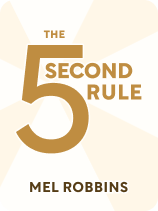

This article is an excerpt from the Shortform book guide to "The 5 Second Rule" by Mel Robbins. Shortform has the world's best summaries and analyses of books you should be reading.
Like this article? Sign up for a free trial here.
What is the psychology behind the 5 Second Rule? How can you use the Rule to improve your life?
In The 5 Second Rule, Mel Robbins explains that the 5 Second Rule can be used to improve your life in three ways. These three ways are to jump into action, be bold and follow your gut, and control impulsiveness.
Let’s explore each use in detail and the 5 Second Rule’s psychology.
1) Using the Rule to Jump Into Action
Robbins notes that the 5 Second Rule’s psychology gives you a tool to overcome resistance and complete tasks—especially non-habitual tasks—that previously felt impossible due to anxiety, depression, or lack of motivation.
Mental health struggles and lack of motivation often result in us overthinking our actions. According to Robbins, it takes just five seconds for the brain to convince us not to do something if it isn’t already part of our routine. The brain triggers this overthinking to protect us from possible unknown negative consequences of non-habitual action: When we have the impulse to do something that isn’t part of our routine, the brain generates reasons why that new action may lead to negative outcomes.
For example, let’s say you usually stay home and watch Netflix on your days off work. However, you’ve been feeling stressed lately and know you’d benefit from being active—say, by playing tennis with your friends. You have a gut feeling telling you to change your routine and exercise, but you stop to think about it for just a few seconds and your brain starts overthinking: “What if I can’t play as well as I used to and I feel embarrassed? What if I look silly in my workout clothes?” Because you don’t normally exercise and your brain fears that doing so might have negative consequences, you think of all the reasons you shouldn’t exercise despite knowing you should. The thoughts ultimately prevent you from playing tennis with your friends.
However, if you use Robbins’s 5 Second Rule, you count down from five to one when you first notice yourself overthinking. You can then quickly act on your gut feeling before overthinking overwhelms and stops you. For example, when you use the Rule and reach one, you can interrupt your overthinking and send your friends a text message inviting them to play tennis with you later that day. This confirms your plans and makes it more difficult for your brain to talk you out of following through.
Deciding More Quickly Leads to Better Decisions
Although it may seem foolish to act after just five seconds and without allowing yourself the time to weigh potential risks and dangers, doing so may help you make more rational decisions. In Algorithms to Live By, Brian Christian and Thomas Griffiths explain that when we first encounter a decision, we immediately consider the most important factors at play. These factors shape our initial emotional response; therefore, acting based on a quick gut feeling often leads to the right decision.
However, when we give ourselves more time to consider the decision, we take all sorts of less important factors into account—arguably akin to what Robbins describes as overthinking. Additionally, we give far too much weight to these less important factors, causing us to consistently fail at predicting what will make us happy. The possible negative outcomes of our choices could be an example of these less important factors we would do better to safely ignore, rather than mulling over and overblowing them.
For example, when your gut tells you that you’d be happier playing tennis with your friends than staying home, the evidence you think of first is probably the most accurate—tennis with friends has proven to be fun in the past, or you wouldn’t feel drawn to go. Your reasons to avoid tennis, on the other hand, are likely overblown—your friends probably won’t make you feel embarrassed for playing badly, and if you do feel embarrassed, it probably won’t be as bad as you anticipate.
2) Using the Rule to Be Bold and Follow Your Gut
Robbins also argues that the 5 Second Rule can help you be bold enough to act on your gut feelings. (Robbins refers to this boldness as everyday courage.) She sees boldness as listening to your values and instincts while working through your fears: for example, signing up for an art class because you want to nurture your creative side even though you’re afraid you might not be any good at it. In this context, the Rule helps you to be bold by jolting you out of a fear-based rut and pushing you to act despite your anxieties.
To Robbins, boldness is essential to taking back control of your life. Acting boldly helps you find fulfillment as you accomplish more than you ever thought possible and realize how much agency you have.
(Shortform note: It’s clear how some boldness can help you accomplish what you want in life, but is it truly sensible to go through life ignoring all your fears? How can you distinguish boldness from recklessness? In The Dichotomy of Leadership, Jocko Willink and Leif Babin advise constantly taking action in pursuit of your goals, but simultaneously, fully considering the risks and rewards of any given decision. Consider potential negative outcomes so that you’re fully prepared for them, but don’t let them scare you into inaction. Additionally, if anyone you trust warns you that you’re being reckless, seriously consider whether they may be right.)
3) Using the Rule to Control Impulsiveness
While the Rule’s main purpose is to encourage action, Robbins argues that it can also help you to control harmful impulses (for example, impulsively saying something hurtful out of anger). She recommends giving yourself five seconds to calm down before you act. Spending a few seconds focusing only on counting backward—and not on your impulse to act harmfully—gives your brain time to dismiss the impulse, thus preventing you from enacting it.
(Shortform note: Instead of solely relying on how well you can use the Rule to calm your state of mind, you may have an easier time restraining yourself from harmful impulses by structuring your environment in a way that weakens those impulses. In Atomic Habits, James Clear suggests making habitual impulses more difficult and less rewarding to follow. For example, if you have the impulse to scroll through Instagram before bed and want to quit, you could intentionally refrain from charging your phone to make following the impulse more difficult, and follow accounts you dislike to make it less rewarding.)

———End of Preview———
Like what you just read? Read the rest of the world's best book summary and analysis of Mel Robbins's "The 5 Second Rule" at Shortform.
Here's what you'll find in our full The 5 Second Rule summary:
- Why counting down from five to one will help you assert agency over your life
- The different ways you can use the 5-Second Rule
- How to figure out what your passions are and work toward them






